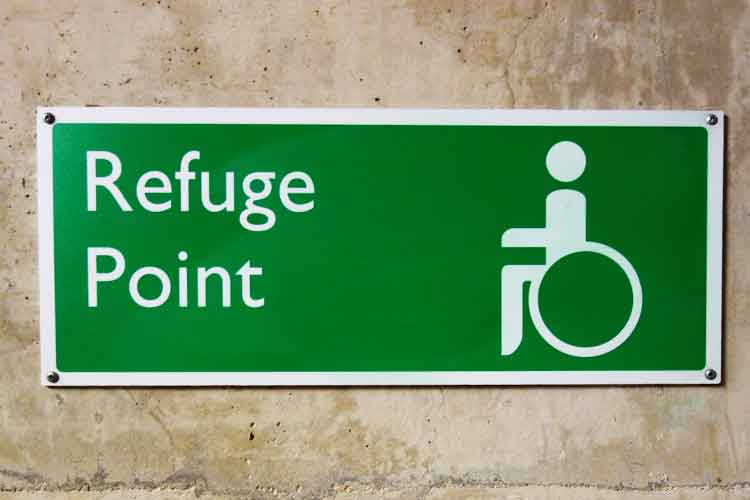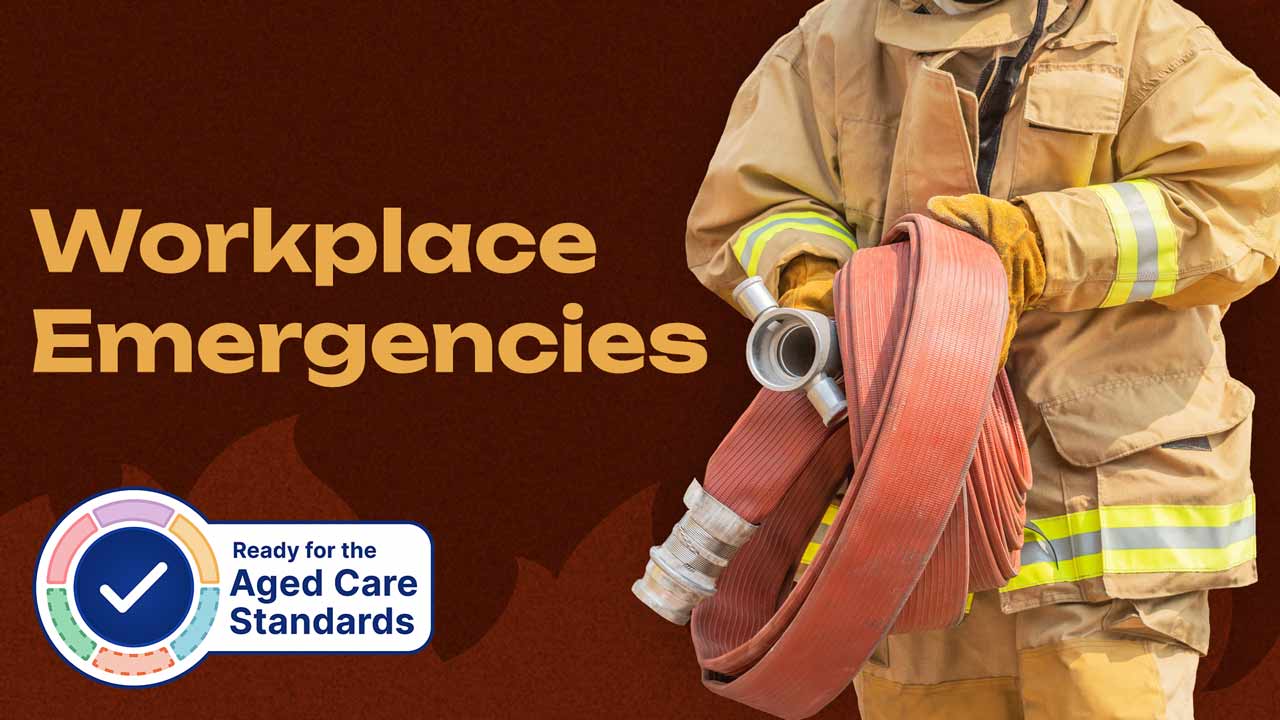Do you know what to do if there is an emergency at your workplace?
You should. In Australia, during an emergency situation, healthcare providers are required to maintain quality care and services to their clients (Aged Care Act 1997).
Depending on the severity and nature of the emergency, this could mean anything from keeping clients calm and comfortable to assisting with a facility-wide evacuation.
The following article will help familiarise you with what you need to know should you find yourself in an emergency situation at your workplace. Note, however, that this piece is only intended as a supplementary guide, and you should refer to and familiarise yourself with your organisation’s emergency policy and procedures at all times.
What is a Workplace Emergency?
Correctly identifying a workplace emergency situation is vital to responding appropriately and quickly. Some healthcare settings, such as emergency departments, will be confronted with emergency situations as routine. A workplace emergency, however, refers to an unexpected situation that:
- Threatens employees, residents, and patients, and/or members of the general public
- Disrupts workplace operations
- Causes physical and/or environmental damage
(SafeWork NSW 2023)

Types of Emergencies
Some examples of emergency situations include:
- Fires and smoke
- Explosions
- Armed confrontations
- Personal injury or threats
- Bomb threats
- Suspicious mail or packages
- Biohazard or chemical spills
- Gas leaks
- Natural disasters
(Safe Work Australia 2021; UWA 2023)
Workplace Emergencies Under the Strengthened Aged Care Quality Standards
Standard 2: The Organisation - Outcome 2.10: Emergency and disaster management of the strengthened Aged Care Quality Standards sets out the responsibilities of aged care providers during emergencies and disasters (ACQSC 2024). These include:
- Developing emergency and disaster management plans that outline how staff should respond to an emergency and manage risks to people’s health, safety, and wellbeing (Action 2.10.1)
- Implementing strategies for preparing for and responding to emergencies and disasters (Action 2.10.2)
- Speaking to staff, older people, and their loved ones about the organisation’s emergency management plans (Action 2.10.3)
- Testing and reviewing emergency management plans frequently in partnership with staff, older people, and their loved ones, and other response partners (Action 2.10.4)
(ACQSC 2024)
What to Do in an Emergency
In an emergency, call 000 or local emergency services.
As in any normal emergency situation, the first responder to identify the emergency should notify emergency services as soon as possible by calling triple-zero (000) (or equivalent local emergency services) (DoHaAC 2024).
Refer to your organisation’s Emergency Risk Management Plan (DoHaAC 2024).
Emergency Planning
Healthcare facilities should be well prepared and able to respond to various emergency events that may impact the provision of care. As a ‘person conducting business or undertaking’ (PCBU), it is regulated by Safe Work Australia that your organisation has an emergency plan in place (Safe Work Australia 2021).
An emergency plan is a set of instructions outlining what to do in an emergency situation and must include:
- Emergency procedures and responses to emergencies
- Evacuation procedures
- Notifying emergency services as soon as possible
- Directions for any medical treatment and assistance required
- Effective communication between the authorised emergency response coordinator and the rest of the workplace
- Testing of the emergency procedure
- Information, training and instruction to relevant workers in relation to implementing the emergency procedures
(Safe Work Australia 2021)
Emergency Control Organisation (ECO)
An essential part of having an emergency plan is identifying the personnel in charge of developing and executing it. Australian Standard 3745-2010: Planning for emergencies in facilities mandates that an Emergency Control Organisation (ECO) be established in all workplaces, comprising senior staff members and employees (EvacServices Team 2018). The ECO should be tasked with implementing all emergency response procedures, including evacuating all building occupants (First 5 Minutes 2023).
The ECO generally includes a Chief Fire Warden, Deputy Chief Warden/Emergency Coordinator, Floor/Area Wardens and Wardens/Emergency Officers. Each member of the ECO should be provided with the necessary training to perform their roles in an emergency.
Important: identify and take note of who the fire/emergency wardens are in your workplace or immediate ward/floor.
Evacuation Procedures

In a care setting such as a residential care facility, the stakes of an emergency are often higher due to the number of residents who are frail or have a mobility impairment. If a full evacuation during an emergency is necessary, it is important to be aware of your facility’s evacuation procedures.
People’s needs will vary in an emergency situation. When developing an evacuation plan, your emergency response coordinators should give some special consideration to managing the evacuation of vulnerable people.
Some recommended strategies could include the following:
People using wheelchairs and mobility devices: |
Keep wheelchair ramps and access points free. If in a multi-storey building, elevators should not be used - particularly if there is a fire. If a person using a wheelchair can not easily get out of the building, fire-isolated stairwells can provide limited safe refuge during a fire, until emergency services arrive. Ensure the building’s fire warden is notified of this. |
People who are deaf / hard of hearing: |
Flashing light-alarms should accompany any emergency alarms, or if not available, persons should be tasked with notifying and assisting residents with hearing loss. |
People who are blind / have low vision: |
Ensure fire-escape stairwells are sufficiently lit and alarms can be heard in all rooms of the facility. |
People with cognitive impairment and disability: |
People with cognitive impairment and disability may have difficulty recognising an emergency. Assigning an evacuation ‘buddy’ can help reduce stress and provide support and guidance in this situation. |
Have a plan for alternate accommodation: |
In the event of a facility-wide evacuation, residential aged care facilities should identify alternative accommodation options for relocation. If assistance is required to identify alternate lodgings, the Department of Health recommends contacting them for assistance. |
(Job Access 2016; UWA 2023; Aged Care Guide 2022)

Training is Key
The success of emergency risk management plans and procedures relies on a steadfast testing and training schedule.
Practical emergency training exercises such as regular fire drills help ensure the emergency plan translates into practice, helping staff identify their roles in an emergency.
Basic emergency and evacuation training should be mandatory and given to all employees. This will generally involve limited fire equipment training, evacuation procedures and familiarising themselves with fire exits and the evacuation point for your building (at a minimum) (FCF 2019; Wormald 2019).
For members of the Emergency Control Organisation, in-depth and ongoing training should be provided by your workplace.
Test Your Knowledge
Question 1 of 3
True or false: Developing an emergency plan is not the responsibility of the care facility.
Topics
Further your knowledge
References
- Aged Care Act 1997 (Cwlth), viewed 16 April 2024, https://www.legislation.gov.au/Details/C2019C00199
- Aged Care Guide 2022, Planning for an Emergency While in Aged Care, Aged Care Guide, viewed 16 April 2024, https://www.agedcareguide.com.au/information/planning-for-an-emergency-while-in-aged-care
- Department of Health and Aged Care 2024, Service Continuity and Emergency Events in Aged Care, Australian Government, viewed 16 April 2024, https://www.health.gov.au/topics/aged-care/providing-aged-care-services/training-and-guidance/service-continuity-and-emergency-events-in-aged-care
- EvacServices Team 2018, Roles of the Emergency Planning Committee, EvacServices, viewed 16 April 2024, https://www.evacservices.com.au/the-role-of-the-emergency-planning-committee/
- FCF 2019, ‘Fire Safety for Aged Care Facilities’, FCF blog, 30 April, viewed 16 April 2024, https://www.fcfnational.com.au/blog/fire-safety-for-aged-care-facilities
- First 5 Minutes 2023, Planning for Emergencies in Health Facilities – Training Requirements, First 5 Minutes, viewed 16 April 2024, https://www.first5minutes.com.au/blog/planning-for-emergencies-in-health-facilities-training-requirements/
- Job Access 2016, Evacuation Plans for Employees with Disability, Australian Government, viewed 16 April 2024, https://www.jobaccess.gov.au/employers/evacuation-plans-employees-with-disability
- SafeWork NSW 2023, Emergency Plans, New South Wales Government, viewed 16 April 2024, https://www.safework.nsw.gov.au/safety-starts-here/safety-overview/emergency-plans
- Safe Work Australia 2021a, Emergency Plans and Procedures, Australian Government, viewed 16 April 2024, https://www.safeworkaustralia.gov.au/safety-topic/managing-health-and-safety/emergency-plans-and-procedures
- The University of Western Australia 2023, Emergency Procedures, UWA, viewed 16 April 2024, https://www.safety.uwa.edu.au/incidents-injuries-emergency/procedures
- Wormald 2019, Fire Safety Advice: Aged Care Facility Managers, Wormald, viewed 16 April 2024, https://wormald.com.au/wp-content/uploads/2019/10/FactSheet_AgedCare_Jul19-1.pdf
 New
New 

